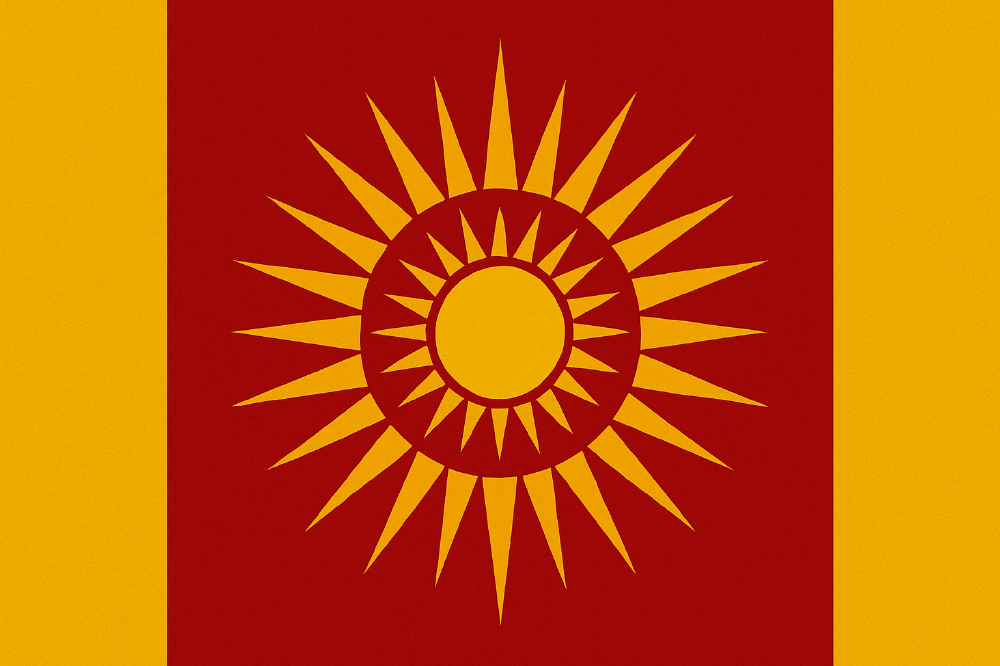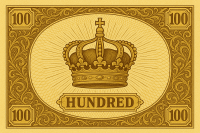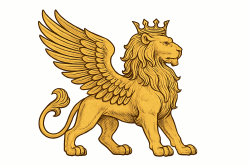| History: |
Ancient Era - The Golden Age (???-800 AD) :
The Suryavanshi Empire was a grand monarchy renowned for its master astronomers mapping the stars from the observatories high up in the Rudrang mountain range, numerous ports, large and small, agriculture and a trade fleet that was hardly rivaled. The empire boasted large fertile plains. About 34 percent of the total economy was dependent on farms and cattles. Around 400 AD, Suryavanshis were known to control about 35 percent of the global trade. The borders of the empire were vast, and spanned across the east southern asia to the central asia. The first recorded history of the empire begins with a civilization that rose from the banks of Devanadi river. According to the foundational epic, the Surya Purana, the first emperor was a semi divine being that descened upon earth, guided by a celestial winged lion - the first Udaykar.
The nation attracted scholars and poets, and numerous epics were written about the conquests of the first emperor, about the majesty of Udaykar, and about his personal life. The people, common or nobles, developed the philosophical tenets of Dharma that would evolve into modern day Hinduism and codified laws based on duty (Kartavya) to one's family, community and the state. The Suryavanshis were renowned for their spiritual wisdom and hospitality. The military was a professional warrior caste, the Kshatriya, who revered Udaykar as their guardian spirit. This age was followed by the succession of weak willed emperors and a shift from collective duty to individual luxury, slowly eroding the golden age.
The Age of The Fractured Sun (800 AD - 1805 AD)
With the collapse of the empire, the Suryavanshi scattered into numerous principalities. This was a long and bloody period were powers collided over greed, envy, pride and wrath. Eventually three central powers emerged from the centuries of chaos -
• The Mountain Kingdom of Rudra-Dev -
Based in the harsh northern peaks that also contained the modern Rudramalla region, the kingdom worshipped the warrior god Shiva. Its people were hardy, martial, and fiercely independent. The rule was based on merit, strength and resourcefulness.
• The Satyan Theocracy -
A state ruling the central plains from the city-state of Satyapura, led by a council of orthodox hindu priests who sought out to preserve the spiritual legacy of the Suryavanshi.
• The Vijayan Maritime Confederacy -
A league of coastal city-states, with its hub in Vijayawada, focused on trade, wealth, and naval power. The decisions were made by a council of leaders each representing their own city-state. The balance of power was uneven, with higher contributing states having more say in decision making.
The Battle of the Three Rivers (c. 1342 CE) -
The confluence of three major tributaries of the Devanadi River was a strategic prize eyed by all principalities. In a bid for ultimate supremacy, the three powers along with many numerous city-states met in a cataclysmic battle. The Rudra-Dev infantry, the Satyan war elephants, and the Vijayan mercenaries clashed for several years. The result was a bloody stalemate and mutual annihilation. Tens of thousands died, and most of the principalities were so weakened that they became easy prey for outside forces. The battle is now taught to every Suryan child as the ultimate lesson in the folly of disunity.
The Dystopia of the Meridian Combine (1805 - 1926) -
Weakened and divided, the principalities were no match for the economic might of the foreign Meridian Trading Combine, resulting in a slow and painful takeover. The Combine offered loans, grants, modern technology and weapons to the competing principalities, trapping them in inescapable debt. This century is regarded as the darkest days for the Suryavanshi people. They installed puppet rulers, stripped the Rudrang mountain ranges of their precious resources and converted the fertile land to crash crops for export, leading to widespread famines. Millions have been estimated to have died. Traditional crafts were destroyed for cheap imported goods. The poverty rate rose to an all time high of 89 percent. Jobs and livelihoods were ruthlessly snatched, and once proud workers were reduced to petty criminals. The trials were rigged and innocent and guilty alike were milked out for anything they could offer to the Combine. The once proud warriors traditions were dismantled and soldiers were reduced to being hired security for Combine managers. National identity was suppressed, culture was commodified, and the people lived in a state of powerless servitude to faceless foreign corporations. Dissents and any attempt to show national unity were ruthlessly purged. The names of tens of thousands of people were silently removed from the pages of history. It was an age of humiliation and despair.
The Age of False Dawn (1926 - 2025) -
As global power dynamics shifted, the Combine's influence waned, and they abruptly withdrew, creating a massive power vacuum. In its place, a civilian government - The Republic of Suryam, was hastily established by the local elites who had profited under the tyrannical Combine regime.
This era was a different kind of dystopia. Freedom from the Combine did not bring prosperity, but chaos. The new republic was hopelessly corrupt, with political dynasties treating the state coffers as their personal bank accounts. Infrastructure and livelihoods crumbled. The military was underfunded, poorly equipped, and used by politicians to settle personal scores. They had hastily written a national anthem and prepared a national flag to foster unity but in the wake of widespread corruption, hardly anyone trusted the government. Rebels were starting to unite in underground bunkers, and the nation was spurring close to a civil war. It was during this period that a young Veerbhadra rose through the ranks, his heart burning at his nation's degradation. He watched as politicians sold the national port in Vijayawada to foreign interests for a pittance, the final act of betrayal that became a stepping stone for the Sunrise Revolution.
The Sunrise Revolution (2025) -
On a moony night, General Veerbhadra, now controlling a large section of the army launched the Sunrise Revolution. It was not a traditional battle, but a planned surgical strike. His loyal units simultaneously secured the capital, arrested the entire corrupt political class, and seized the state broadcaster on the same night. The entire operation was so swift and well planned that the influential powers didn't have any chance to amass their troops.
At dawn, Veerbhadra addressed the nation. He spoke of the glory of the Suryavanshi, now Suryans, the tragedy of the Three Rivers, and the humiliation of the Combine and the Republic. He dissolved the "false republic" and declared the founding of the Stratocratic State of Suryavart, with himself as Sanchalak (Director). He promised an end to chaos and the beginning of a new era of "Pragati me Vijay". The populace, already weary of corruption and instability, largely welcomed the coup. |
| Terrain: |
The Rudrang Range - Crown of Suryavart
Dominating the northern frontier, the Rudrang Range is a breathtaking wall of granite and ice. The name is formed of two words - Rudra + Ang, meaning a part of Rudra, hindu god of arts and destruction. He resides on the top of mount Kailash, a snowcapped mountain. The Suryavanshis believed the Rudrang range to be an extension of his will.
Topography: Characterized by jagged, saw-toothed peaks, many of which remain snow-capped year-round. Deep, narrow valleys are present throughout the range, creating dangerous but strategically vital passes like the infamous Black Ridge Pass. Glaciers grind slowly down the top of the slopes, meeting the rivers below. The nation's highest point, the formidable Mount Vayu (22,800 ft), is considered a national tourist spot.
Devanadi Heartlands - Suryavart's lifeline
Flowing south from the Rudrang glaciers, the Devanadi River creates a vast and fertile alluvial plain. This is the agricultural core of Suryavart.
Topography: A wide, flat expanse, sloping towards the southern sea. The landscape is inhabited by a large Suryan population. The mighty Devanadi irrigates the land and provides power by a series of dams and levees. A grid-like network of irrigation canals, built by the Suryan Services, crisscrosses the plains, ensuring water reaches every corner of the state-run farms.
The Satkhanda Plateau - Udaykar's Abode
Lying between the mountains and the coastal plains is the Satkhanda Plateau, the "Land of Seven Parts." This is a wilder, less tamed region of the nation.
Topography: A landscape of hills, broken terrain, and dense teak and sal forests. The plateau is cut by deep ravines and filled with hidden valleys. It is here that the mythological Udaykar is said to make its home. The terrain makes large-scale agriculture difficult, and it remains sparsely populated.
The Dakshin Coast - Gateway to the World
The southern edge of Suryavart is a long, humid coastline bordering the sea.
Topography: A mix of long, sandy beaches, rocky promontories, and dense mangrove swamps at the mouth of the Devanadi River delta. The coastline is vulnerable to cyclones during the monsoon season. |














